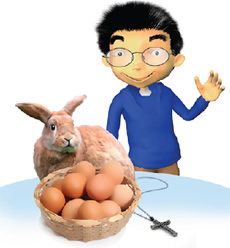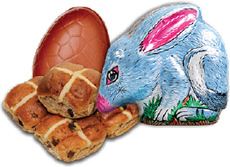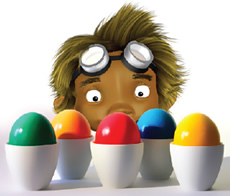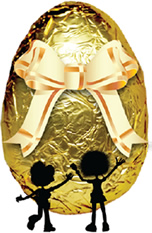Easter is a time for celebrating new life. Easter does not have a set date and its time each year varies according to moon phases. Many countries around the world celebrate Easter according to their own traditions and religious beliefs.
The Christian Easter
For Christians, Easter focuses on the crucifixion of Jesus Christ and his resurrection (coming back to life) three days later. Jesus was arrested by the Romans and put to death by crucifixion, after being betrayed by his friend Judas, who told the Romans where to find him. After his death, on what we now call Good Friday, Jesus’ body was placed in a tomb that was covered by a large stone. Three days later, on Easter Sunday, the tomb was found empty and news spread that Jesus had risen from the dead.
Easter traditions

Generally, Easter occurs somewhere between late March and late April. Easter Sunday falls on the first Sunday after the full moon in autumn in the southern hemisphere and spring in the northern hemisphere.
Northern hemisphere spring festivals celebrating the end of winter, the arrival of spring and the coming of new life have existed since ancient times.
Easter occurs at a slightly different time each year. It is based on rules and traditions relating to various calendars (such as Hebrew, Julian or Gregorian) and moon phases.
Symbolism
There are many symbols that have come to be associated with Easter. Here are a few examples:
A Cross – Jesus was crucified on a wooden cross and these have come to symbolise his death and his resurrection three days later on Easter Sunday.
Eggs – symbolise new life and rebirth.
Rabbits – symbolise fertility and new life.
Lambs – represent spring and new life. Lambs also have links to Jesus who was called the ‘Good Shepherd’ and was referred to as a sacrificial lamb.
Palm fronds – symbolise peace and have links to the Bible which tells of Jesus being greeted with palm fronds when he arrived in Jerusalem just days before he was arrested.
Purple – the colour of royalty and a sign of mourning. Churches often use the colour purple throughout Easter to mourn Jesus’ death.
Religious observances
Lent

Lent is an old tradition that some Christians still partake in. During this period (the forty days before Easter) many people fast or give up particular luxuries. Some people give up simple items such as chocolate, while others do not eat meat, fish, eggs or dairy.
The last week of Lent is called the Holy Week. Palm Sunday is the day that Jesus arrived in Jerusalem. Maundy Thursday is the day of the Last Supper and Good Friday is the day of Jesus’ crucifixion and death. Easter Sunday comes as a huge celebration at the end of Lent with feasting and treats, commemorating the day that Jesus rose from the dead.
Shrove Tuesday
The day before Lent begins is called Shrove Tuesday or Pancake Day. Traditionally, a feast was held on this day to use up all of the food that people would not be able to eat during Lent. Pancakes were a popular recipe to get rid of eggs and milk.
Australia
In Australia we celebrate Easter over a four day long weekend. The weekend begins on Good Friday and ends with Easter Monday. Many Christians go to church on Good Friday or Easter Sunday. Easter Sunday is usually celebrated with the giving of chocolate Easter eggs and with chocolate bilbies instead of the traditional chocolate rabbit. Like rabbits, the Easter bilby has long pointy ears and fine fur. The bilby is our preferred creature in Australia because rabbits are often viewed as pests that take over the habitat of native animals.

Many Australian children participate in an Easter egg hunt on Easter Sunday to discover what goodies might have been hidden by the Easter bilby over night. Another treat which Australians enjoy eating over Easter is the hot cross bun. These delicious treats are traditionally made with spices and dried fruit and are decorated with a white cross. Today, many modern variations of the hot cross bun exist such as chocolate or mocha.
Easter in other countries
Greece
Easter in Greece is a very religious time, churches are decorated and religious processions are held. Eggs are painted red to represent the blood of Christ. Traditionally, when people meet they knock their eggs together and say ‘Christos anesti!’ meaning ‘Christ is risen!’ Many people also view the cracking of the eggs to be symbolic of Jesus breaking out of his tomb.
Germany
Germany has a number of Easter traditions. Easter Sunday is known as ‘Family Day’. Lots of sweet treats are eaten, including a cake shaped like a lamb, and eggs and cookies are hidden in the garden. Many Germans also have an ‘Easter Fire’ where they burn their Christmas tree to show that winter is over and spring is coming. It is also popular in Germany to have an egg tree. Real eggs are painted and then hung from branches in a vase inside the house. Some people go to huge efforts to cover an entire tree in their garden with these delicate egg ornaments.
Hungary

In Hungary, Easter is celebrated with the baking of delicious pastries and the painting of hardboiled eggs. People in northeast Hungary celebrate with an interesting Easter ritual called the ‘Watering of the Girls’ or ‘Dousing Day’. Girls and boys wear traditional dress, then the girls run down the street while the boys throw buckets of water on them (to ensure they will become good wives)! Afterwards, the girls reward the boys who splashed them with coins or Easter eggs painted with flowers.
Russia
As in many countries, eggs are decorated at Easter. During the nineteenth century, Russia took this to a whole new level of extravagance. Born in 1846, Peter Carl Fabergé worked as a jeweller and gold-smith for the Russian Imperial Court, creating jewelled masterpieces for Russia’s royalty and nobility.
The Tsar Alexander III had Fabergé create an Imperial Easter Egg as a gift for the Empress each Easter. Each egg took a year to create as they were highly decorated and made out of precious stones and metals such as gold, silver, pearls, rubies and diamonds. Each egg held a surprise, some opened to reveal a beautiful pendant, a portrait or a golden hen inside.
Easter fast facts

- It is believed that the word ‘Easter’ may come from ‘Eostre’ (sometimes called ‘Eostare’), the Anglo-Saxon goddess of sunrise and spring, who had festivals and feasts held in her honour during April.
- The cross on hot cross buns is there to remind us of the crucifixion of Jesus Christ.
- Eggs are often ‘blown’ to empty them of their contents before they are painted. Each end of the egg is pricked, and then air is blown into one end so that the yolk and white comes out of the other. The delicate hollow eggshells can then be painted.
- One of the world’s largest chocolate Easter eggs measured over 27 feet tall and weighed over 4000kgs.
- In Australia many special events occur over the Easter long weekend such as the Sydney Royal Easter Show, the National Folk Festival in Canberra and the Blues and Roots Festival in Byron Bay. Some great matches in Australian Football are scheduled for this weekend and sailing events also occur in different locations around Australia.




